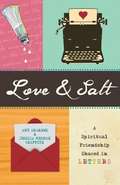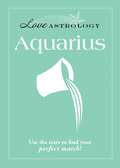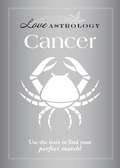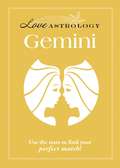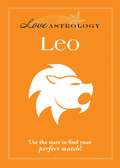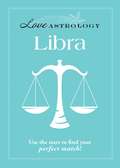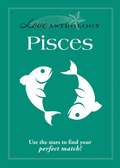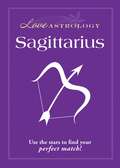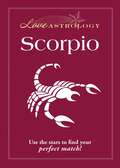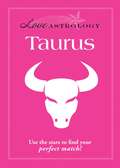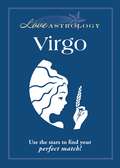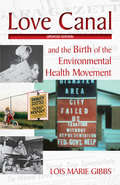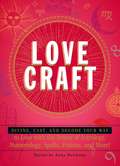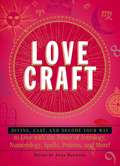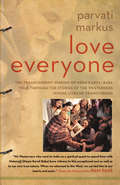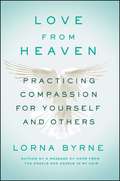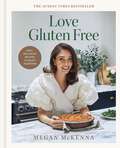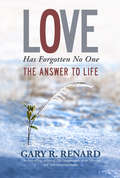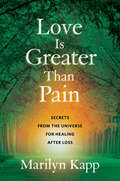- Table View
- List View
Love And Salt: A Spiritual Friendship Shared In Letters
by Amy Andrews Jessica Mesman GriffithWhen Amy Andrews and Jessica Mesman Griffith met in a creative writing class in graduate school, they both confessed to writing about God. They bonded one night while reading the Book of Ruth and came to truly understand the unlikely friendship of Ruth and Naomi. In these two Old Testament women, they witnessed a beautiful spiritual friendship and a way of walking with one another toward God. But how could they travel this path together when they would be separated by distance and time and leading busy lives as they established marriages and careers? They decided to write letters to each other--at first, for each day of Lent, but those days extended into years. Their letters became a memoir in real time and reveal deeply personal and profound accounts of conversion, motherhood, and crushing tragedy; through it all, their faith and friendship sustained them. Told through the timeless medium of letters--in prose that is raw and intimate, humorous and poetic--Love & Salt is at its core the emotional struggle of how one spiritual friendship is formed and tested in tragedy, tempered and proven in hope. Includes bibliographic reference.
Love Astrology: Aquarius
by Adams MediaLooking for love, Aquarius? Then look to the stars. With Love Astrology: Aquarius as your astrological dating guide, you’ll learn important information on how your sign affects your love life - and how you can use these secrets of the stars to find your perfect mate. Here’s your chance to find your fated match!
Love Astrology: Aries
by Adams MediaLooking for love, Aries? Then look to the stars. With Love Astrology: Aries as your astrological dating guide, you’ll learn important information on how your sign affects your love life - and how you can use these secrets of the stars to find your perfect mate. Here’s your chance to find your fated match!
Love Astrology: Cancer
by Adams MediaLooking for love, Cancer? Then look to the stars. With Love Astrology: Cancer as your astrological dating guide, you’ll learn important information on how your sign affects your love life - and how you can use these secrets of the stars to find your perfect mate. Here’s your chance to find your fated match!
Love Astrology: Capricorn
by Adams MediaLooking for love, Capricorn? Then look to the stars. With Love Astrology: Capricorn as your astrological dating guide, you’ll learn important information on how your sign affects your love life - and how you can use these secrets of the stars to find your perfect mate. Here’s your chance to find your fated match!
Love Astrology: Gemini
by Adams MediaLooking for love, Gemini? Then look to the stars. With Love Astrology: Gemini as your astrological dating guide, you’ll learn important information on how your sign affects your love life - and how you can use these secrets of the stars to find your perfect mate. Here’s your chance to find your fated match!
Love Astrology: Leo
by Adams MediaLooking for love, Leo? Then look to the stars. With Love Astrology: Leo as your astrological dating guide, you’ll learn important information on how your sign affects your love life - and how you can use these secrets of the stars to find your perfect mate. Here’s your chance to find your fated match!
Love Astrology: Libra
by Adams MediaLooking for love, Libra? Then look to the stars. With Love Astrology: Libra as your astrological dating guide, you’ll learn important information on how your sign affects your love life - and how you can use these secrets of the stars to find your perfect mate. Here’s your chance to find your fated match!
Love Astrology: Pisces
by Adams MediaLooking for love, Pisces? Then look to the stars. With Love Astrology: Pisces as your astrological dating guide, you’ll learn important information on how your sign affects your love life - and how you can use these secrets of the stars to find your perfect mate. Here’s your chance to find your fated match!
Love Astrology: Sagittarius
by Adams MediaLooking for love, Sagittarius? Then look to the stars. With Love Astrology: Sagittarius as your astrological dating guide, you’ll learn important information on how your sign affects your love life - and how you can use these secrets of the stars to find your perfect mate. Here’s your chance to find your fated match!
Love Astrology: Scorpio
by Adams MediaLooking for love, Scorpio? Then look to the stars. With Love Astrology: Scorpio as your astrological dating guide, you’ll learn important information on how your sign affects your love life - and how you can use these secrets of the stars to find your perfect mate. Here’s your chance to find your fated match!
Love Astrology: Taurus
by Adams MediaLooking for love, Taurus? Then look to the stars. With Love Astrology: Taurus as your astrological dating guide, you’ll learn important information on how your sign affects your love life - and how you can use these secrets of the stars to find your perfect mate. Here’s your chance to find your fated match!
Love Astrology: Virgo
by Adams MediaLooking for love, Virgo? Then look to the stars. With Love Astrology: Virgo as your astrological dating guide, you’ll learn important information on how your sign affects your love life - and how you can use these secrets of the stars to find your perfect mate. Here’s your chance to find your fated match!
Love Canal: and the Birth of the Environmental Health Movement
by Lois Marie GibbsToday, "Love Canal" is synonymous with the struggle for environmental health and justice. But in 1972, when Lois Gibbs moved there with her husband and new baby, it was simply a modest neighborhood in Niagara Falls, New York. How did this community become the poster child for toxic disasters? How did Gibbs and her neighbors start a national movement that continues to this day? What do their efforts teach us about current environmental health threats and how to prevent them? Love Canal is Gibbs' original account of the landmark case, now updated with insights gained over three decades.
Love Craft: Divine, Cast, and Decode Your Way to Love with the Power of Astrology, Numerology, Spells, Potions, and More!
by Anna HaywoodYour guide to manifesting love!The love you want is out there--it just needs to be channeled into your life. With Love Craft, you'll use ancient arts like astrology and the Law of Attraction to draw in the perfect relationship, one that meets all your desires and needs. This book also provides you with a revealing look into your past relationships and ideal partner. With this profound wisdom, you'll learn how to:Use the power of soul numbers to test your cosmic chemistrySet the intentions that will attract the love you deserveConcoct an enchanting meal that will nudge a love interestUse a sun sign's traits to ignite passion in the bedroomAlign your relationships with the lasting energies of the stars and planetsWhether you're already paired up or still looking for that special someone, Love Craft helps you bring unwavering love into your life.
Love Craft: Divine, Cast, and Decode Your Way to Love with the Power of Astrology, Numerology, Spells, Potions, and More!
by Anna HaywoodYour guide to manifesting love!The love you want is out there--it just needs to be channeled into your life. With Love Craft, you'll use ancient arts like astrology and the Law of Attraction to draw in the perfect relationship, one that meets all your desires and needs. This book also provides you with a revealing look into your past relationships and ideal partner. With this profound wisdom, you'll learn how to:Use the power of soul numbers to test your cosmic chemistrySet the intentions that will attract the love you deserveConcoct an enchanting meal that will nudge a love interestUse a sun sign's traits to ignite passion in the bedroomAlign your relationships with the lasting energies of the stars and planetsWhether you're already paired up or still looking for that special someone, Love Craft helps you bring unwavering love into your life.
Love Everyone: The Transcendent Wisdom of Neem Karoli Baba Told Through the Stories of the Westerners Whose Lives He Transformed
by Parvati MarkusA celebration of one of the most influential spiritual leaders of our time: Neem Karoli Baba, the enlightened guru who inspired a generation of seekers—including Ram Dass, Daniel Goleman, and Larry Brilliant—on life-altering journeys that helped change the world.In 1967, Ram Dass returned to the West from India and spread the teachings of his mysterious guru, Neem Karoli Baba, better known as Maharajji. Ram Dass’s words about Maharajji’s life-affirming wisdom resonated with a youth culture that had grown disillusioned with the violence, civil discord, and crude materialism of modern civilization. Hundreds of Westerners traveled to India and experienced Maharajji’s extraordinary presence directly until his death in 1973. His simple directives—love everyone, feed everyone, and remember God—opened their hearts and awakened their souls.What these followers brought back to the West has since changed the landscape of everyday life. Meditation is now mainstream; yoga studios are in every town; and mindfulness is practiced in elementary schools and board-rooms everywhere, from Silicon Valley to Capitol Hill. A stirring piece of history, Love Everyone brings these stories to life, sharing for the first time the inspiring tales of the men and women who followed the siren call of the East to the foothills of the Himalayas, then returned to forever reshape the world.A compelling and inspiring tribute to Maharajji from the Western men and women who knew him best, Love Everyone is a profound teaching on the power of love, as lasting and transformative as the truth, wisdom, and bliss of Maharajji.
Love Food and Live Well: Lose Weight, Get Fit, and Taste Life at Its Very Best
by Chantel HobbsGo ahead. Get passionate about the food you eat. You don&’t have to hide it. You can love food and lose weight at the same time! The secret, which you&’ll learn about in Love Food and Live Well, is to know when to have carrot cake and when it&’s time for just a carrot. For most dieters, food is the daunting factor that trips up our best intentions to lose weight and get fit. Let Chantel Hobbs teach you that food is not the enemy! It&’s our attitudes toward it that defeat us. Losing weight does not require being deprived of the foods you love and being forced to eat boring, tasteless meals, and left feeling hungry most of the time. Turn food into your ally by following Chantel&’s 80/20 rule: A full 20 percent of the time, splurge on the foods you love and incorporate them into celebrations and social occasions. The remaining 80 percent of the time, choose food on the basis of delivering maximum fuel for your body and ultimate health. Simply by having freedom in what you eat, you can train yourself in self discipline and achieve sustainable weight loss, being free from food anxiety. Using personal inventories, original recipes, food plans, and new, detailed exercises for strength training and aerobic fitness, Chantel will inspire you to live well in every area of life. What are you waiting for? Start the pursuit of a life lived well and healthy: body, mind, and spirit.
Love From Heaven: Practicing Compassion for Yourself and Others
by Lorna ByrneBestselling author and mystic Lorna Byrne teaches us how to have more compassion for both ourselves and others and to see all the love around us in this powerful and moving book—perfect for fans of Louise Hay and Doreen Virtue.Lorna Byrne, an Irish mystic, has been seeing angels since she was a baby, but she sees even more than that. In Love from Heaven, she reveals for the first time that she sees love as a physical force. Lorna first became conscious that the angels were teaching her about love when she was five years old, and today she can see how love manifests in each of us. She sees that newborn babies are full of pure love and that many teenagers and adults seem surrounded at the heart level by a transparent but ironlike band, which restricts that love. We are all pure love, but nine out of ten of us have locked away most of this love within ourselves. This love remains there, though—indestructible and ready to be released, if only we can learn to love ourselves first. Love from Heaven will transform the way you think about love, stir up the love within, and make you more compassionate, leading to a happier life for you and those around you.
Love Gluten Free: Easy, delicious recipes to enjoy together
by Megan McKenna'I really hope you love making the recipes in this book as much as I do. So get your apron on, light a few candles, pour a glass of wine or fizz and get yourself in that kitchen. Gluten-free people can eat good food too, and this is proof!'An empowering and joyful new cookbook that shows how eating gluten-free has never been easier - or more delicious. In her new book, TV personality and Celebrity Masterchef finalist Megan McKenna is determined to re-define gluten free cooking, sharing 80 delicious recipes that spark joy for her and that are perfect for enjoying with loved ones, regardless of dietary requirements.Crowd-pleasing brunch recipes such as Baked Feta Bruschetta, Fluffy Pancakes with Bacon, Berries & Maple and Egg, Spinach and Feta muffinsRomantic date night dishes such as Megan's take on Marry-me Chicken, Pink Sauce spaghetti with Lardons & Walnuts and Mini Heart PizzasDelicious home comforts such as Short Rib Ragu of Dreams, Three-Cheese Crispy Mac & Cheese and Steak PieFun and tasty sharing plates (perfect for a celebration) such as Buffalo Chicken Bites, Barbecue Pulled Pork with Pineapple & Mini Tacos and Cider Battered FishFakeaways such as Hoisin Duck Summer Rolls, Egg Fried Rice and McK Apple PiesSince her coeliac diagnosis as a child and with a total social media following of 4.5 million, Megan McKenna speaks for a generation who are keen to create tasty recipes that are accessible for everyone, so there is no need to make a separate portion of gluten-free food when friends and family gather together to enjoy a delicious homecooked meal.
Love Gluten Free: Easy, delicious recipes to enjoy together
by Megan McKenna'I really hope you love making the recipes in this book as much as I do. So get your apron on, light a few candles, pour a glass of wine or fizz and get yourself in that kitchen. Gluten-free people can eat good food too, and this is proof!'An empowering and joyful new cookbook that shows how eating gluten-free has never been easier - or more delicious. In her new book, TV personality and Celebrity Masterchef finalist Megan McKenna is determined to re-define gluten free cooking, sharing 80 delicious recipes that spark joy for her and that are perfect for enjoying with loved ones, regardless of dietary requirements.Crowd-pleasing brunch recipes such as Baked Feta Bruschetta, Fluffy Pancakes with Bacon, Berries & Maple and Egg, Spinach and Feta muffinsRomantic date night dishes such as Megan's take on Marry-me Chicken, Pink Sauce spaghetti with Lardons & Walnuts and Mini Heart PizzasDelicious home comforts such as Short Rib Ragu of Dreams, Three-Cheese Crispy Mac & Cheese and Steak PieFun and tasty sharing plates (perfect for a celebration) such as Buffalo Chicken Bites, Barbecue Pulled Pork with Pineapple & Mini Tacos and Cider Battered FishFakeaways such as Hoisin Duck Summer Rolls, Egg Fried Rice and McK Apple PiesSince her coeliac diagnosis as a child and with a total social media following of 4.5 million, Megan McKenna speaks for a generation who are keen to create tasty recipes that are accessible for everyone, so there is no need to make a separate portion of gluten-free food when friends and family gather together to enjoy a delicious homecooked meal.
Love Has Forgotten No One: The Answer To Life
by Gary R. RenardIn this fascinating book, Gary R. Renard and his Ascended Master teachers, Arten and Pursah, guide you through a way of dissolving the illusions of time and space and returning to Reality, which is Perfect Love. This is not love in the way the world commonly thinks of it. It's an all-encompassing kind of love that is perfect spirit: innocent, unflawed, immortal, invulnerable, and forever fearless.Real love, which is Divine in nature, must be experienced, for it is beyond words. Yet words and practice are needed to help lead you to that experience. The knowledge of what it's like to be one with your Source is the awesome mystical experience that's been described by Masters throughout the ages. It's the greatest sense of awareness anyone can have while still appearing to be in this world. This book will teach you exactly how to get to that experience, which upon the end of your physical existence will become your permanent reality. You will find that, indeed, love has forgotten no one.
Love Has Seven Colors: Heart-Centered Practices for the Energy Centers
by Jack AngeloA guide to restoring your connection to the wisdom of your soul and returning to heart-centeredness• Explains how unconditional love allows the 7 main energy centers to create the human rainbow• Describes how each energy center processes life and reflects physical, mental, emotional, and spiritual well-being• Includes 29 breathing, relaxation, meditation, and visualization exercises to reconnect with the heart center and access soul guidanceEach of us has a light body connecting the spiritual, emotional, and physical levels of our being. When we live in a heart-centered way and choose love as the basis for our actions rather than fear, each of the 7 energy centers of the light body opens to the wisdom of our souls and radiates with a different color, making us walking rainbows of unconditional love and soul guidance.Presenting the Inner Circle Teachings on heart-centeredness from the ancient mystery schools, Jack Angelo explains how unconditional love positively affects our subtle energy system and allows our 7 energy centers to form the full rainbow of connection between our hearts, minds, and souls. Describing the location and color of each energy center and the ways they can affect our physical, emotional, and mental well-being, he shows how the 7 energy centers control the flow of energy to and from the multiple levels of our being and process the energies generated by specific life issues. Providing 29 breathing, relaxation, meditation, and visualization exercises, the author explores how to open each energy center to the intelligence of the heart and retrain the mind to approach life with love instead of fear. He explains the role of the heart center in healing and how to balance the masculine intelligence of the mind with the feminine intelligence of the heart. Once the energies of these two polarities are balanced, we become truly heart-centered, radiating the 7 colors of love and following the wisdom of our soul to discover the spiritual reality of our sacred self.
Love Is Greater Than Pain: Secrets from the Universe for Healing After Loss
by Marilyn KappAn extraordinary new mindful approach to healing after loss that taps into everyone&’s ability to continue their relationship with those who have passed.&“Marilyn&’s vast and masterful experience in communicating with passed loved ones illustrate what they want to teach us.&”—Betty Jampel, LCSWWhen Marilyn Kapp was two years old, she watched her grandfather leave his body. He told her he would be back and he was true to his word. When Marilyn realized that others did not share her perception of the spiritual plane, she kept her channeling abilities to herself and her family. This changed when, as a college student, she met writer, Holocaust survivor, and future Nobel laureate Elie Wiesel. He became her mentor and encouraged her to use her perception to help others.In Love Is Greater Than Pain, Marilyn shares her profound understanding of the afterlife. Today a renowned medium, Marilyn reveals the beauty in the transition from the physical to the spiritual plane, helping those who are dying, as well as those left behind. With personal stories and transcripts from channeling sessions, Marilyn teaches us how to interact with the afterlife and to joyfully embrace the reality that love truly is greater than pain.Marilyn shares universal messages of comfort, forgiveness, and understanding, including specific guidance for bereaved parents, for those dealing with dementia, and even for people who are grieving for their animal friends. Marilyn&’s groundbreaking seminal work offers practical advice, clear takeaways, and a new approach to death, grieving, and living your best life, sharing concrete steps for:• Raising your personal vibration to increase health, joy, and the ability to receive channeled information and love.• Helping yourself and others honor life while grieving.• Understanding the parallel process of growth that we share with those who have passed.When we honor life as we grieve, we offer healing and support to one another, as well as conscious collaboration with those who have passed.
Love Is Love (Lorimer Real Love)
by Mette BachInsecure about her body and unhappy at home, Emmy will do anything to be liked. But after rumors spread about her sexual experience, Emmy leaves her hometown to stay with family in Vancouver. She finds herself instantly attracted to her cousin's confident, transgender friend, Jude. Emmy is never sure where she stands with Jude, and can't believe that such a confident, charismatic guy might actually be interested in her. Getting to know Jude helps Emmy realize it's worth it to put your true self out there for real love. Distributed in the U.S by Lerner Publishing Group
